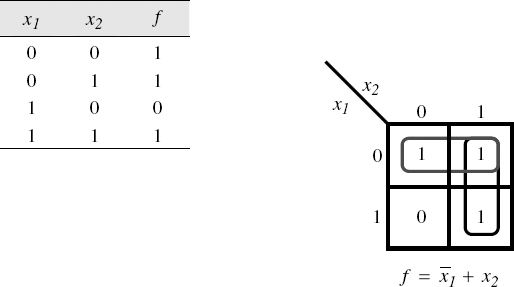6.4 TWO-VARIABLE KARNAUGH MAP
An example of a Karnaugh map for a two-variable function is shown in Figure 6.3. Each value of the truth table is represented in the Karnaugh map. A 1 appears in both columns of the top row. Therefore, there exists a single product term that can cause f to be equal to 1 when the input variables have values that correspond to either of these cells. These values have been circled and are identified as x1 = 0, but x2 equals 0 for the left column and 1 for the right. This implies that if x1 = 0, then f = 1, regardless of the value of x2. The product term represented by this circle is simply ![]() . Similarly, if x2 is 1, then regardless of x1, the function f will also equal 1. Hence, the minimum realization for the logic function f can be expressed as
. Similarly, if x2 is 1, then regardless of x1, the function f will also equal 1. Hence, the minimum realization for the logic function f can be expressed as

Figure 6.3 Karnaugh Map Simplification of a Two-Variable Logic Function
![]()
Algebraic simplification yields the same logic expression. Therefore, to find a minimum implementation for a given logic function, it is necessary to find the smallest number of product terms that produce a value of 1 for all cases. At the same time, the number of these product terms should be as low as possible. Notice how some of the 1's are ...
Get Introduction to Digital Systems: Modeling, Synthesis, and Simulation Using VHDL now with the O’Reilly learning platform.
O’Reilly members experience books, live events, courses curated by job role, and more from O’Reilly and nearly 200 top publishers.

